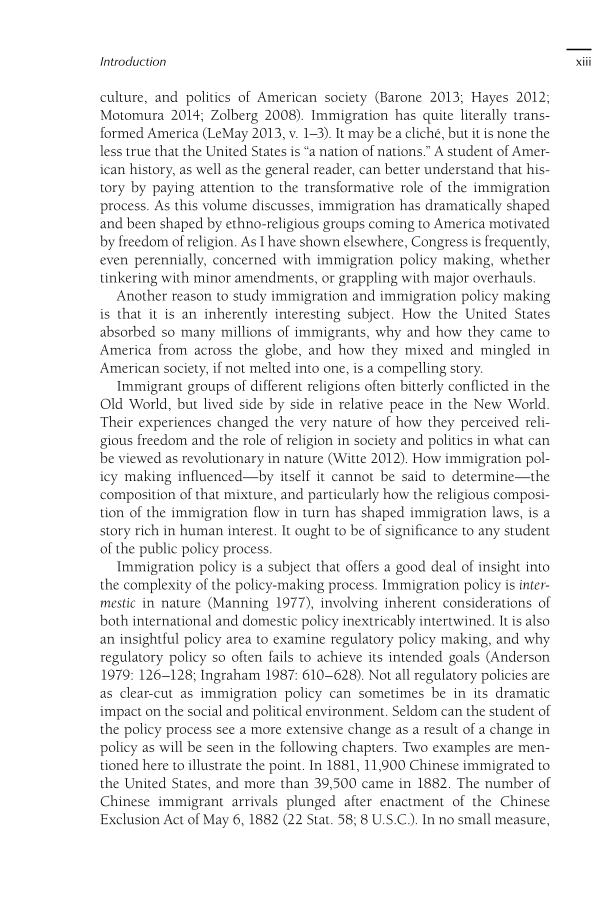Introduction xiii culture, and politics of American society (Barone 2013 Hayes 2012 Motomura 2014 Zolberg 2008). Immigration has quite literally trans- formed America (LeMay 2013, v. 1–3). It may be a cliché, but it is none the less true that the United States is “a nation of nations.” A student of Amer- ican history, as well as the general reader, can better understand that his- tory by paying attention to the transformative role of the immigration process. As this volume discusses, immigration has dramatically shaped and been shaped by ethno-religious groups coming to America motivated by freedom of religion. As I have shown elsewhere, Congress is frequently, even perennially, concerned with immigration policy making, whether tinkering with minor amendments, or grappling with major overhauls. Another reason to study immigration and immigration policy making is that it is an inherently interesting subject. How the United States absorbed so many millions of immigrants, why and how they came to America from across the globe, and how they mixed and mingled in American society, if not melted into one, is a compelling story. Immigrant groups of different religions often bitterly confl icted in the Old World, but lived side by side in relative peace in the New World. Their experiences changed the very nature of how they perceived reli- gious freedom and the role of religion in society and politics in what can be viewed as revolutionary in nature (Witte 2012). How immigration pol- icy making infl uenced—by itself it cannot be said to determine—the composition of that mixture, and particularly how the religious composi- tion of the immigration fl ow in turn has shaped immigration laws, is a story rich in human interest. It ought to be of signifi cance to any student of the public policy process. Immigration policy is a subject that offers a good deal of insight into the complexity of the policy-making process. Immigration policy is inter- mestic in nature (Manning 1977), involving inherent considerations of both international and domestic policy inextricably intertwined. It is also an insightful policy area to examine regulatory policy making, and why regulatory policy so often fails to achieve its intended goals (Anderson 1979: 126–128 Ingraham 1987: 610–628). Not all regulatory policies are as clear-cut as immigration policy can sometimes be in its dramatic impact on the social and political environment. Seldom can the student of the policy process see a more extensive change as a result of a change in policy as will be seen in the following chapters. Two examples are men- tioned here to illustrate the point. In 1881, 11,900 Chinese immigrated to the United States, and more than 39,500 came in 1882. The number of Chinese immigrant arrivals plunged after enactment of the Chinese Exclusion Act of May 6, 1882 (22 Stat. 58 8 U.S.C.). In no small measure,
Document Details My Account Print multiple pages
Print
You have printed 0 times in the last 24 hours.
Your print count will reset on at .
You may print 0 more time(s) before then.
You may print a maximum of 0 pages at a time.




































































































































































































































































































































